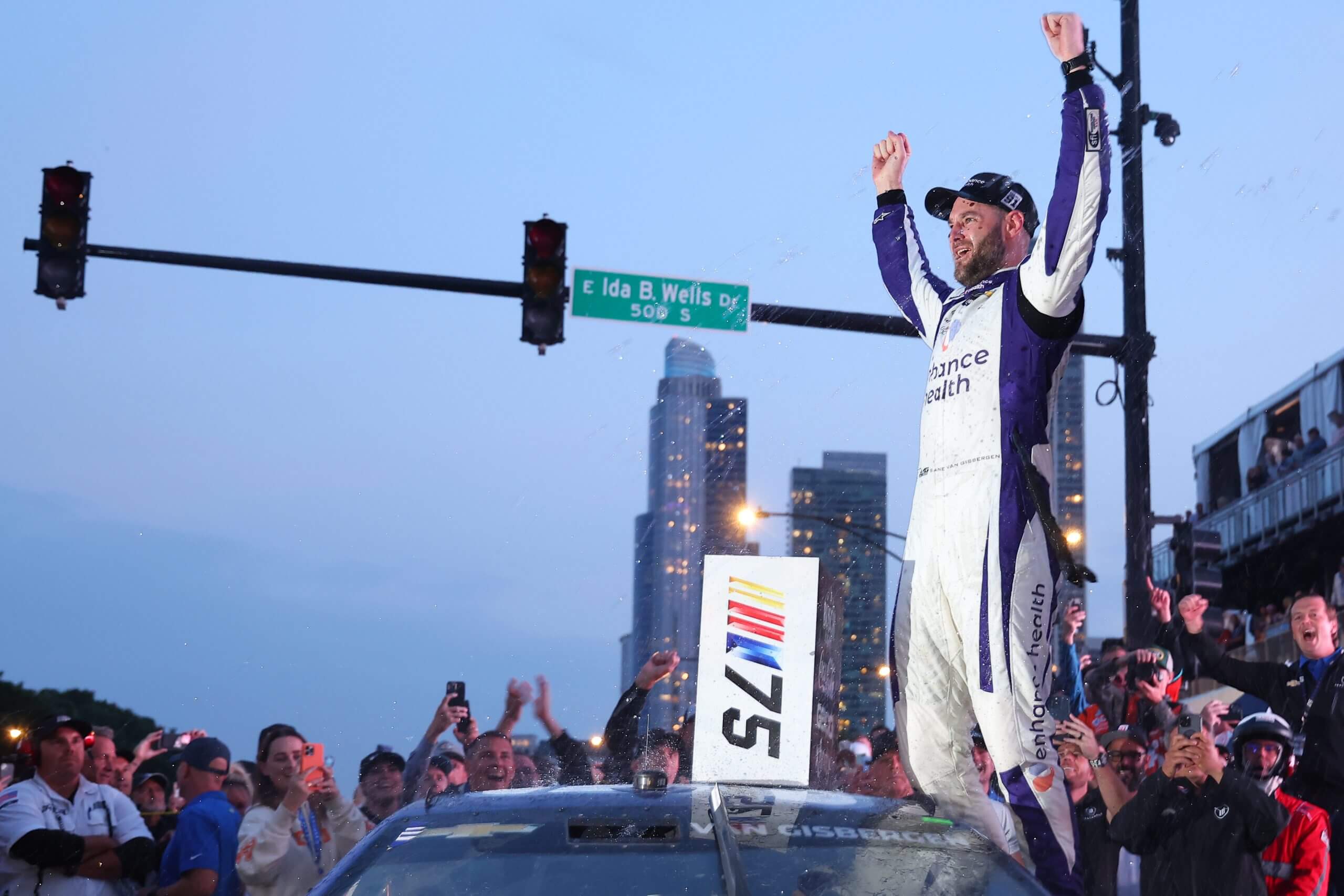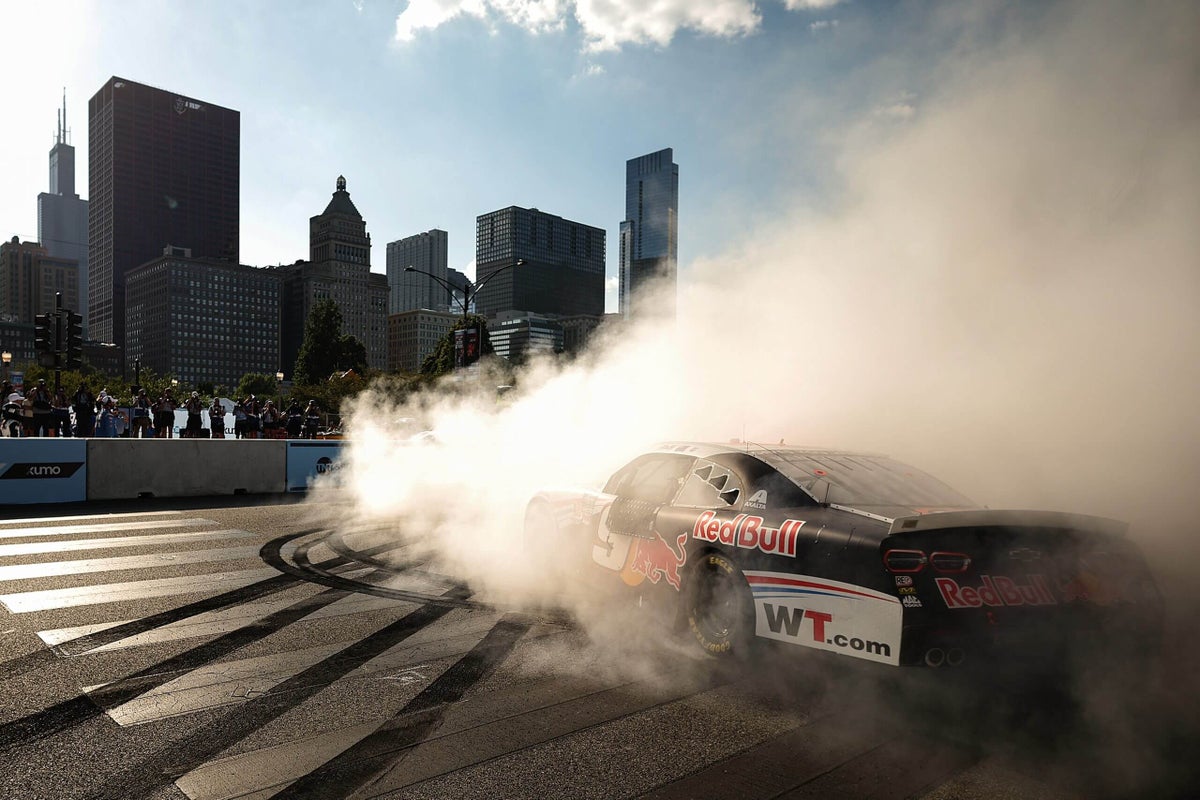CHICAGO — NASCAR stock cars will roar down Michigan Avenue, DuSable Lake Shore Drive and other streets around Chicago’s Grant Park for perhaps the final time on Sunday afternoon, marking the conclusion of an eventful and weather-marred three-year contract.
Meteorologists are calling for rain on race day for the third consecutive year, and the long-term forecast for the race’s future on the NASCAR schedule looks gloomier. While considered a remarkable feat in the NASCAR world, the race has also been an expensive proposition for the sanctioning body — more than $50 million spent for the inaugural race in 2023, with less attendance than originally hoped.
The grandstands, hospitality areas and concert venue have been pared down for this year’s edition of the race. Meanwhile, The Athletic has reported NASCAR is in talks for a San Diego street race next year — and it’s unclear whether there could be room for two such events on the calendar.
But if this is the last one in Chicago, drivers certainly aren’t cheering its demise. Despite widespread industry skepticism before the first edition of the race, Chicago has become a signature event that presents a different experience than most on the NASCAR schedule.
“It’s probably my favorite event in NASCAR each year,” said Kyle Larson, a three-time winner this season in the Cup Series.
Favorite? Of all 38 races?
“I mean, name a better one,” he said.
Larson rattled off a list of pluses for the Chicago race: Drivers enjoy staying in a hotel across the street and walking to the racetrack. There are endless nice restaurants. The city is beautiful. And the racing has been surprisingly good. From Larson’s view, what’s not to like?
It wasn’t always evident it would turn out this way. In the lead-up to the inaugural race, Chicago politicians and residents alike raised a fuss over road closures, traffic, and concerns about everything from dog-walking disruptions to asking track president Julie Giese if there was a chance of cars crashing into buildings.
Meanwhile, there was hand-wringing in the NASCAR garage over headlines about high crime and worries about whether the Cup Series cars would be able to have a good show on such a narrow course.
Then, in the middle of the first day of on-track activity in 2023, the first rain hit. The city evacuated the entire park due to lightning, and NASCAR was forced to cancel high-profile concerts that night to the dismay of many fans who were sold on the “music festival with a race” concept.
Suddenly, it seemed like the event might be doomed before it even got started.
“That first year on the Saturday, the amount of people coming in here for the concert was insanity,” Spire Motorsports driver Michael McDowell said. “It was going to be a giant success. And then, obviously, the weather and the thunderstorms.”
The next day, a large storm caused the track to flood. The rain swirled around on the radar like a small hurricane. Finally, the skies cleared enough for New Zealand native Shane van Gisbergen to win a thrilling race in his NASCAR debut, broadcaster NBC had its highest NASCAR viewership in six years, and the race was viewed as a hit despite the rain. It won “Event of the Year” at the Sports Business Awards.

Shane van Gisbergen won the inaugural Chicago Street Race in 2023. The event has earned praise despite two years of rain-marred competition. (Michael Reaves / Getty Images)
Mother Nature struck again last year, causing more delays and shortening the race. And Chicago might get drenched again on Sunday, if those forecasts are correct.
Still, an often-cynical NASCAR garage has refreshingly focused on the rays of sunshine poking through the clouds when it comes to Chicago.
“It’s had to go through a lot of adversity, but the race itself and the city and the track are awesome,” McDowell said. “It accomplished what we wanted to accomplish: Bringing the race to the fans and not the fans to the race.”
Giese said more than 80 percent of ticket-buyers in the first year had never previously been to a NASCAR race; that number dipped to a still-impressive 70 percent in Year 2 and was tracking similarly for Sunday.
Drivers don’t have that data at their fingertips, but their anecdotal evidence has put Chicago in a favorable light. Driver/team owner Denny Hamlin said there was “more excitement around the venue itself than what a normal race venue has” and was pleased to hear non-NASCAR fans at his hotel discussing the race.
His experiences led him to stump Saturday for a return to Chicago because it has stayed true to the original goal: Creating a massive, in-person promotion geared toward an audience who might not otherwise even consider watching a NASCAR race.
“I (went) shopping, and I go to all these different stores,” Hamlin said. “(The conversations were,) ‘What are you in town for? Oh, yeah, there’s a race. We were talking about going to that. We didn’t go last year because of the rain, but we’re thinking about going.’
“That’s what you want. These are younger people who are not going to travel to Chicagoland (Speedway, an oval in Joliet, about 40 miles away from Grant Park) to go to a race. You have to have it right here where they can walk to it.”
But that’s also the dilemma for NASCAR. This isn’t F1, which never races on an oval and conducts its championship circuit exclusively on street circuits and road courses. Nor is this IndyCar, which has a sprinkling of ovals on a calendar otherwise dominated by road racing.
NASCAR has six non-ovals per season, and Chicago is the only street course race. Street courses are tighter and less forgiving than natural road courses, which have plenty of runoff areas unrestrained by real-life city avenues and obstacles like sidewalks and bus stops.
While Chicago has allowed new fans to see the cars and drivers up close, it’s also not a true sampling of the core NASCAR product.
That’s one reason Hendrick Motorsports driver Chase Elliott has been such a strong advocate of seeing NASCAR race at the Nashville Fairgrounds short track near that city’s center and repeatedly praised NASCAR for building a small oval inside the Los Angeles Memorial Coliseum for its preseason exhibition “Clash” race from 2022-2024.
“There’s nothing that’s going to top giving people a true short track (in Nashville),” Elliott said. “What is NASCAR? Here it is. Take an Uber from Broadway to the racetrack and go watch.
“That is the biggest home run waiting to happen. But this is a good second choice, as far as getting inside a big-city market. It’s been a lot of fun to come do it.”
Regardless of whether Chicago sticks, it’s a given that the NASCAR schedule will continue evolving. And that’s a recent development for a series which once had such a stale calendar that Joey Logano considered a “big change” was “moving a date a couple weeks.”
These days, NASCAR has taken some wild chances. It raced inside the L.A. Coliseum. It tried a dirt race. It took a gamble on the small-capacity Bowman Gray Stadium earlier this year. It took the Cup Series to Mexico City last month for the first international points race in the Modern Era.
But nothing compares to what it accomplished logistically in Chicago. A series without any street course setup experience convinced city leaders they could pull it off and then did, constructing a world-class track that challenged drivers in the heart of the third-biggest American city.
It’s telling that in spite of a trifecta of rainy race days, the Chicago Street Course legacy is likely to still be viewed favorably and as a proof of concept for future street racing events.
“It’s proven being bold can have its benefits if you take big risks,” 2023 Cup champion Ryan Blaney said. “It’s something they’d never done before. They took it head-on.”
“I wish we would have gotten more fortune with the weather, but it’s been a big success. No matter what happens next year, going forward, it’s been really good NASCAR decided to do this. It was a win.”
(Top photo of Shane van Gisbergen celebrating his win Saturday in the Xfinity Series race in Chicago: Chris Graythen / Getty Images)
